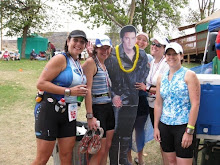Runners skimp on this key nutrient--but you need more than you think
By Christopher Percy CollierPUBLISHED 03/28/2008
Go to any prerace party or postrun potluck and you'll see legions of runners twirling forks in huge plates of spaghetti. And why not? Carbs are king, right? Except you may be missing out on another essential running nutrient, especially if you've been following the government's dietary guidelines. In September, the International Society of Sports Nutrition (ISSN) released a position paper by nine researchers in the field of protein and exercise. Their message? People who engage in regular exercise, like runners, don't just need more calories than desk jockeys, they need more protein.
"With every footstrike, a runner carries two to seven times his or her body weight," says Douglas Kalman, Ph.D., R.D., who has done extensive research on the effects of protein in athletes. "Protein is what keeps your body healthy under all that strain." Adequate protein intake accelerates muscle growth and speeds recovery by helping rebuild muscle fibers stressed during a run. Since protein helps muscles heal faster, runners who consume the right amount are less likely to get injured. The reverse is also true, according to the authors of the ISSN paper: Athletes who get insufficient amounts of protein are at a higher risk of injury.
What's more, high-protein intake has been shown to help maintain a strong immune system. "After an intense bout of exercise, your immune system is weakened for about four to five hours," says Richard Kreider, Ph.D., one of the ISSN study's authors and head of the Exercise and Nutrition Laboratory at Baylor University. "Protein stimulates white blood cells, which helps shield against upper-respiratory problems." Military research studies show that Marines who ingested high amounts of protein had fewer medical visits than those with lower protein intake.
Just How Much?
The USDA's Recommended Dietary Allowance (RDA) for protein is .8 grams per kilogram (or .36 grams per pound) of body weight. But that's not enough for athletes, according to the ISSN, which says endurance athletes like runners need 1.0 to 1.6 grams per kilogram a day (or .45 to .72 grams per pound). That translates into 75 to 120 grams of protein daily for a 165-pound runner. Don't worry about "overdosing" on protein. While some reports claim that high-protein intake is linked with kidney problems and calcium loss, the ISSN says it's not a concern for healthy athletes.
Lean meats and other animal products, like eggs, milk, and whey (a by-product of milk), pack a lot of protein. Four ounces of chicken breast, for example, contain about 32 grams of protein. The fat in food interferes with the rate of protein absorption, so limit your intake of high-fat foods, such as rib eye or prime rib. Vegetable-based sources, such as beans, lentils, nuts, seeds, and soy, aren't as protein-dense--a half cup of black beans, for example, has about eight grams--and they fall short on all nine essential amino acids, the chemical building blocks of protein (the exception is soy). Runners who avoid animal products can make up for this deficit by eating a variety of the most protein-rich vegetables and grains, such as soybeans, oats, and quinoa. "Not all the protein in a food is easily absorbed by your body," says Kalman. "But you'll probably get enough as long as you eat a lot of different kinds of food."
So before you get in line for another serving of spaghetti, take a hard look at your plate. Chances are you should add some grilled chicken.
[Here's] an example of protein intake for one day:
A 165-pound runner needs between 75 and 120 grams of protein daily. Spread intake throughout the day, eating some at each meal, to ensure your body has a steady supply.
7 a.m.
3/4 cup oatmeal + two scrambled eggs + six ounces orange juice + cup of coffee with skim milk = 25 grams
10 a.m.
Banana + two tablespoons peanut butter = 8 grams
11 a.m. (prerun)
Half a bottle of protein sports drink (about four grams of protein per serving) + 12 p.m. (postrun)Second half of the sports drink = 8 grams
1 p.m.
Two slices whole-wheat bread, four ounces sliced turkey, one ounce sliced reduced-fat cheese, lettuce, tomato, mustard + six ounces fat-free yogurt = 40 grams
6 p.m.
Mixed-greens salad with peppers, cucumber, and tomato; one tablespoon balsamic vinaigrette dressing + four ounces grilled salmon + 1 1/2 cups steamed broccoli and cauliflower + one medium baked sweet potato = 33 grams
Protein Total=114 grams
























